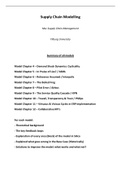Samenvatting
Summary of all models (Supply Chain Modelling)
- Instelling
- Tilburg University (UVT)
Summary of all models that were discussed during the course. It is written to the point and contains all the information you need. It is based on the models in Silico and the youtube video's. It is not a simple copy-paste of the slides but a helpful tool for both the tutorials and exam preparati...
[Meer zien]




